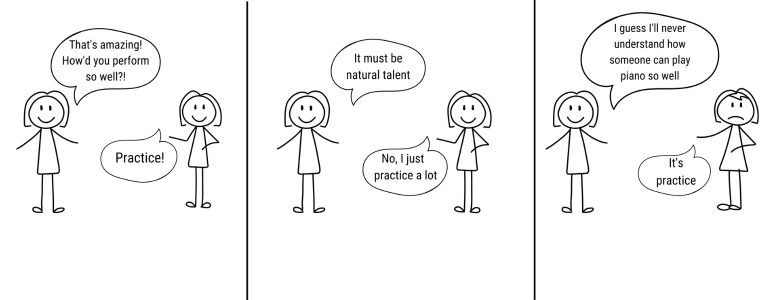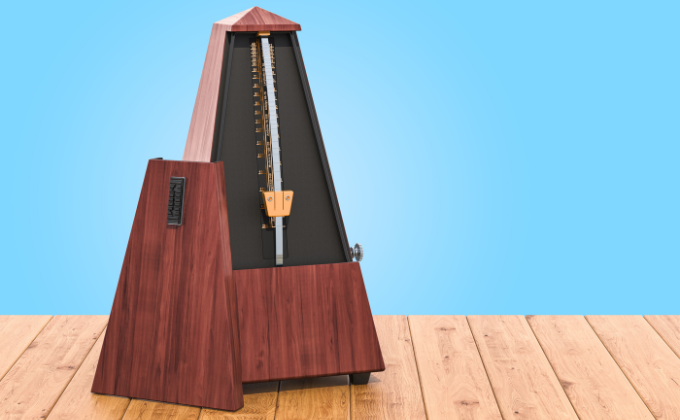
Amanda Shaw-Yagoub lives with her family and a menagerie of small pets on a little island near Montreal, Quebec. She’s a writer, translator, musician and homegrown teacher who loves to share her passions with others. When she’s not out exploring her island or taking care of the many beasts who depend upon her, she’s teaching piano, English literature or ESL. The most heard phrase in her studio (and the one which elicits the most giggles and groans from her students) is, “Play it again!”
Your students look up to you. Your musical talent is what they aspire to and they want to learn from you because you have so much to teach them. But that doesn’t mean we’re flawless musicians. Part of being a great teacher is being able to show that we’re still learning, too. Our students have to be able to relate to us.

There are many ways to nurture positive, authentic teacher-student relationships. But one of my favourites is simply to show students that I’m human – and by that, I mean letting them see that I’m still growing in my musicianship – just like them.
Oftentimes students only hear how we play their pieces. Or they might listen to us play one of our own pieces that’s fully polished and ready to perform.
But if they can hear us working on a piece – even struggling with a piece – it’s another chance to build a connection. “This is what musicians do…and you and I are both musicians!”
But how can we create these connections in our piano studios?
6 Ways to Model the Learning Process
We can’t just go about our business and expect our students to pick up on what we’re doing. So don’t just tell your students to practise – show them how. Here are 6 ways you can do just that.
No. 1: Practise, Practise, Practise
One of my favourite memes on social media goes like this:

Practice is something that usually happens behind the scenes. But if we can show our students that we have to work hard at the piano, too, and if we can model for our students exactly how we do it, then we can truly inspire young musicians.
Show them you’re in it, too. Solidarity in challenging circumstances can be a very effective motivator.
Demonstrate how you work through a piece bit by bit. You could have a lot of fun here by swapping roles – encourage your students to become the teacher and find the best practice strategy for you to use.
No. 2: Ask Them For Help
You’re always involved in your students’ learning process – now get them involved in yours! I ask even my youngest students to help me in some way. It can be as simple as clapping out the rhythm of the first couple of measures of a piece I’m working on, or finding the first note.
With my more advanced students, I ask them to identify the key or even play a couple of bars (measures) for me. We often discuss why some parts may be more difficult than others, or which section I might want to learn first.
By asking for their opinion and getting them involved in my own learning process, I’m valuing their musicianship and independence – which is highly motivating for students.
No. 3: Point Out the Tricky Parts
When a student asks me to play something for them, I love to pull out a work I’m in the throes of learning. “This one has tricky fingering,” I’ll say, or, “I can play it slowly, but I’m still working on the tempo.”

This is a great teaching opportunity. The key here is to be as specific as possible. You could point out things like:
- unusual time signatures
- complicated keys
- tricky rhythms
- difficult tempos
- intense dynamic changes
When you approach these tricky parts with an air of excitement – as challenges to conquer rather than things to stop you in your tracks – you’re modelling a gritty, growth-oriented mindset.
No. 4: Play it Again
When my students are struggling with a piece, I have them repeat the trickiest bar (measure) or phrase over and over again.
I have six vegetable-shaped erasers that I set at the bottom of the keyboard. Each time the student correctly plays the identified bars (measures), they move one vegetable across to the other side of the keyboard.
It adds a little fun to the sometimes tedious process of working on one challenging spot, and gives the brain a moment (even if it’s a short moment!) to process what just happened.
To model for them how I’m working on a piece, I do the same. “These two bars are throwing me for a loop,” I might say. “I’ve been using the veggie erasers to help me work through this part.”
No. 5: Make It a Game
When you prove that working on a piece is a fun, problem-solving activity, practice becomes play. This can be done with a few simple tools such as a pencil and dice or with a specially designed practice activity.

Subscribe to updates and get the Practice Kit
Enter your details to subscribe to the newsletter for piano teachers with information, tips and offers.
I hate spam as much as you do! I’ll only send you information that’s directly relevant to music teachers and you can unsubscribe at any time.
Members of Vibrant Music Teaching can download the full practice kit from the Printable Library.
We love offering these freebies as a sneak peak to the membership, but they’re only the very tippy tippity top of a very huge VMT iceberg! Find out what you’re missing and become a member at vibrantmusicteaching.com.
No. 6: Try a Studio Challenge
Studio challenges are a tangible and visual way to motivate students to get to work on the piano between lessons. To model the effectiveness of a studio-wide challenge, why not join in the fun yourself?!
If it’s a technical challenge, such as chords or scales, you can set up a particularly difficult level for yourself that really would be a challenge (for example, increasing the tempo, moving into unusual jazz chords or incorporating modes).
As you check in on the students’ progress towards their challenge goals, encourage them to check in on your progress at the same time.

Which one of these 6 ways will you use this week?
We all have something to learn. A beginner student right at the start of their musical journey and a teacher with decades of experience have a wealth of untapped potential to grow as musicians.
When we model this learning process for our students, we create a human connection and instill good habits that students will carry with them – hopefully for decades to come.
Share your thoughts in the comments below. 🙂
Visit Nicola’s centralised hub page devoted to all-things-practice for the latest and greatest practice resources.